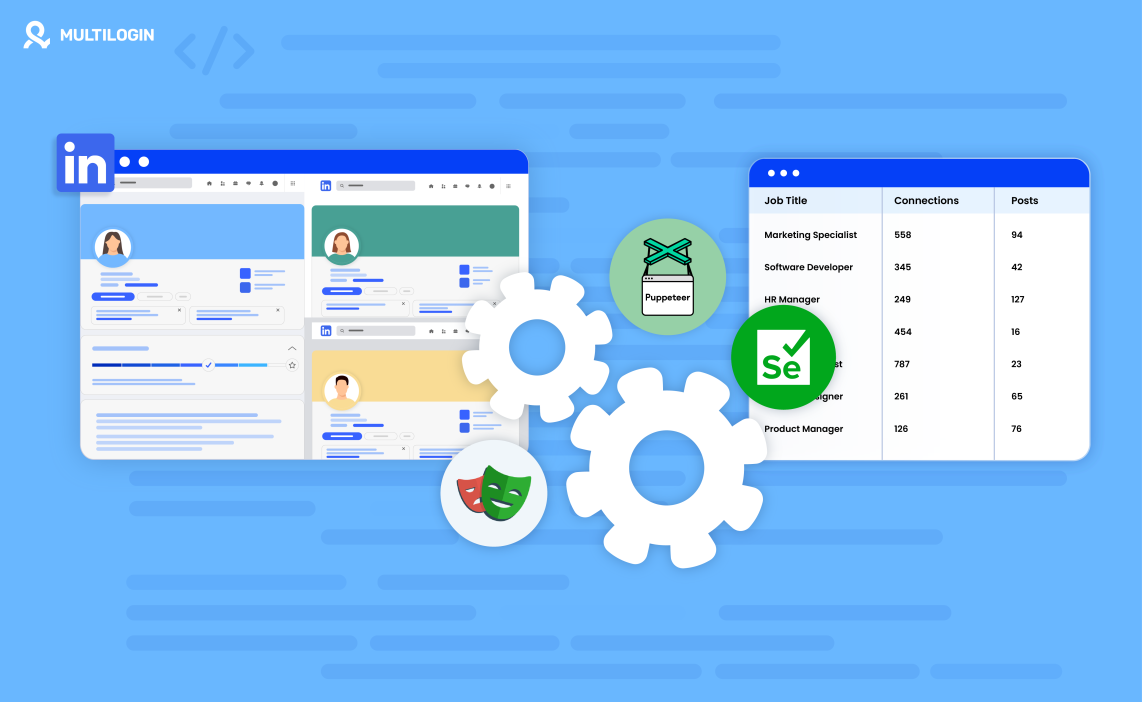LinkedIn is a goldmine of professional data, offering valuable insights into industries, companies, and professionals. However, extracting this data efficiently often requires the use of specialized LinkedIn scraping tools.
These tools help automate the process, allowing you to gather data for market research, lead generation, or competitive analysis.
This article explores some of the best LinkedIn scraping tools available in 2024, offering both free and paid options to suit various needs.
What is LinkedIn Scraping?
LinkedIn scraping involves using automated tools or scripts to extract data from LinkedIn profiles, job postings, company pages, and other areas of the platform. This data can then be analyzed to support business decisions, from identifying potential hires to understanding market trends.
Why Use LinkedIn Scraping Tools?
Efficiency: Manually extracting data from LinkedIn is time-consuming. Scraping tools automate the process, saving you time and effort.
Data Accuracy: Scraping tools can extract large volumes of data quickly and with precision, reducing the chances of errors.
Competitive Advantage: By collecting and analyzing data from LinkedIn, you can gain insights into competitors, potential clients, and market trends.
Best LinkedIn Scraping Tools for 2024
1. PhantomBuster

PhantomBuster is a popular cloud-based scraping tool that offers various “Phantoms” for LinkedIn. These Phantoms allow you to automate tasks like profile scraping, connection requests, and message sending.
Key Features
Automates LinkedIn profile and company data extraction.
Customizable workflows to fit your specific needs.
Integrates with other tools like Zapier for enhanced automation.
Best For: Professionals who need to automate LinkedIn tasks beyond just data scraping.
2. Octoparse
Octoparse is a no-code scraping tool that allows you to extract LinkedIn data without any programming knowledge. It offers a visual interface that simplifies the process of setting up scraping tasks.

Key Features
Drag-and-drop interface for easy setup.
Cloud-based scraping, meaning your tasks run even when your computer is off.
Pre-built templates for LinkedIn scraping tasks.
Best For: Users who prefer a no-code solution and need an easy-to-use interface.
3. Scrapy
 Scrapy is an open-source Python framework for web scraping. While it’s more technical than some other options, it offers unparalleled flexibility for those who are comfortable with coding.
Scrapy is an open-source Python framework for web scraping. While it’s more technical than some other options, it offers unparalleled flexibility for those who are comfortable with coding.
Key Features
High customization for complex scraping tasks.
Fast and efficient, capable of handling large-scale scraping projects.
Extensive documentation and community support.
Best For: Developers and data scientists who require a customizable, powerful scraping tool.
4. DataMiner
DataMiner is a browser extension that allows you to scrape data directly from LinkedIn pages. It’s user-friendly and doesn’t require any coding skills, making it accessible to non-technical users.

Key Features
Easy to use with no coding required.
Supports export to Excel, CSV, and Google Sheets.
Allows for real-time scraping directly from your browser.
Best For: Users who want a quick and simple way to extract LinkedIn data without installing software.
5. SalesQL
SalesQL is a LinkedIn scraping tool designed specifically for lead generation. It allows you to scrape contact details from LinkedIn profiles and save them directly to your CRM.

Key Features
Extracts emails and phone numbers from LinkedIn profiles.
Integrates with CRMs like Salesforce and HubSpot.
Offers a Chrome extension for easy access.
Best For: Sales professionals looking to streamline their lead generation process.
6. Apify
Apify is a versatile web scraping tool that supports LinkedIn data extraction. It offers a range of pre-built scraping templates and the ability to create custom scraping scripts.

Key Features
Supports LinkedIn data extraction through ready-to-use templates.
Offers a robust API for integrating with other tools.
Provides cloud-based scraping with scheduling options.
Best For: Businesses that need a flexible and scalable solution for scraping LinkedIn data.
Free LinkedIn Scraping Tools
For those on a budget, several free LinkedIn scraping tools offer basic functionality:
1. Web Scraper (Chrome Extension)
Web Scraper is a free Chrome extension that allows you to scrape data from LinkedIn directly from your browser. It’s user-friendly but offers limited customization compared to paid tools.
2. Instant Data Scraper
Instant Data Scraper is another free Chrome extension that simplifies LinkedIn data extraction. It automatically detects data on web pages and allows you to export it in various formats.
3. ParseHub (Free Tier)
ParseHub offers a free plan with limited functionality, allowing you to scrape LinkedIn data with some restrictions on the number of pages and data points.
Risks and Legal Considerations
Is LinkedIn Scraping Legal?
LinkedIn’s terms of service explicitly prohibit unauthorized data scraping. Violating these terms can lead to account suspension, legal action, and other penalties. It’s crucial to understand and comply with LinkedIn’s policies before engaging in scraping activities.
Data Privacy Concerns
Scraping LinkedIn data can raise privacy concerns, especially if it involves extracting personal information. Ensure that you comply with data protection laws like GDPR when scraping and using LinkedIn data.
How to Scrape LinkedIn Data Without Getting Banned
Scraping LinkedIn data can be a powerful tool for gathering insights, but it comes with risks, especially since LinkedIn actively works to prevent unauthorized data extraction. To avoid getting banned or restricted, it’s crucial to follow best practices and use tools that help you stay under LinkedIn’s radar.
Here’s how you can scrape LinkedIn data more safely:
1. Use Antidetect Browsers
Antidetect browsers like Multilogin are essential tools for anyone serious about scraping LinkedIn data without getting caught. These browsers allow you to create unique browser profiles, each with its own digital fingerprint, making it appear as though different users are accessing LinkedIn from separate devices. This helps in disguising your scraping activities, reducing the chances of LinkedIn detecting and banning your account.
Isolated Browser Profiles: Antidetect browsers create separate, isolated profiles for each scraping task. Each profile has a distinct set of digital characteristics like IP address, user-agent, and cookies, making it difficult for LinkedIn to link the activity to a single user or device.
Browser Fingerprinting Protection: Tools like Multilogin provide robust protection against browser fingerprinting, a common technique used by LinkedIn to detect automated scraping. By mimicking the behavior of real users, these browsers help you avoid triggering LinkedIn’s anti-scraping mechanisms.
Advanced Security Features: Antidetect browsers also offer advanced security features such as proxy rotation and custom IP addresses, further enhancing your ability to scrape LinkedIn data without getting banned.
Using an antidetect browser is one of the most effective ways to protect your LinkedIn scraping activities, especially when combined with other techniques like proxy rotation and limiting request frequency.
2. Leverage Proxies and VPNs
Proxies and VPNs are critical components in your scraping toolkit. These tools help you mask your real IP address, making it appear as though your requests are coming from different locations. This not only helps in avoiding detection but also in circumventing rate limits imposed by LinkedIn.
Rotating Proxies: Use rotating proxies to change your IP address frequently during scraping sessions. This makes it harder for LinkedIn to associate multiple requests with the same user, reducing the likelihood of a ban.
Residential Proxies: Residential proxies are generally more reliable and less likely to be flagged by LinkedIn compared to data center proxies. These proxies mimic real user connections, further decreasing the chances of detection.
VPNs for Geolocation Control: VPNs allow you to control your geolocation, which can be useful if you’re scraping LinkedIn data across different regions. However, using VPNs alone isn’t enough; combining them with proxies and an antidetect browser offers a more comprehensive solution.
3. Mimic Human Behavior
Automated scraping that looks too mechanical can quickly raise red flags on LinkedIn. To avoid this, your scraping activities should mimic the behavior of real users as closely as possible.
Randomized Delays: Introduce random delays between actions, such as loading pages or clicking on links. This makes your scraping activity appear more natural and less like a bot.
Variable Interaction Patterns: Don’t repeat the same actions in a predictable sequence. Vary your interactions by viewing different types of content, scrolling through pages, or even occasionally pausing for longer periods.
Session Management: Use tools that allow you to manage multiple sessions effectively. This includes saving and resuming sessions so that your scraping activities appear as continuous browsing sessions rather than one-off data grabs.
4. Scrape During Off-Peak Hours
Timing your scraping activities can also play a role in avoiding detection. Conduct your scraping during off-peak hours when LinkedIn’s servers are less likely to be heavily monitored. While this doesn’t guarantee safety, it can reduce the chances of triggering LinkedIn’s anti-scraping mechanisms.
Less Traffic, Less Attention: Scraping when fewer users are active on LinkedIn can help your activities blend into the background noise, making them less noticeable to LinkedIn’s security algorithms.
Scheduled Scraping: Use scheduling tools to automate your scraping tasks during these off-peak hours. This ensures that your scraping is consistent and less likely to be flagged.
5. Monitor Your Account’s Health
Regularly check the health of your LinkedIn account to ensure that it’s not being flagged for suspicious activity. Signs of potential issues include decreased visibility, connection limitations, or sudden account restrictions.
Engagement Metrics: Keep an eye on your engagement metrics, such as profile views and connection requests. Sudden drops could indicate that LinkedIn is limiting your account’s reach.
Notifications and Warnings: Pay attention to any warnings or notifications from LinkedIn about your activity. Address these immediately to prevent further action, such as a ban.
Account Diversity: Consider using multiple LinkedIn accounts for different scraping tasks, ensuring that no single account becomes too overloaded with activity. Using an antidetect browser like Multilogin makes managing multiple LinkedIn accounts safer and more efficient.
6. Stay Updated on LinkedIn’s Policies
LinkedIn’s terms of service and data usage policies are subject to change. Staying informed about these updates is crucial to ensure that your scraping activities remain compliant, or at least within the boundaries of what LinkedIn considers acceptable.
Regularly Review LinkedIn’s TOS: Make it a habit to review LinkedIn’s terms of service periodically. This will help you stay ahead of any changes that could impact your scraping strategies.
Adapt Your Techniques: If LinkedIn introduces new anti-scraping measures, be prepared to adapt your techniques. This could involve changing the tools you use, altering your scraping frequency, or even pausing activities until a safer method is identified.
Using the right combination of antidetect browsers, proxies, and behavioral strategies can significantly reduce the risk of getting banned while scraping LinkedIn. However, it’s important to remember that scraping always carries some level of risk, so taking proactive steps to protect your accounts and data is essential.
FAQs
Is Scraping LinkedIn Allowed?
Scraping LinkedIn is generally against the platform’s Terms of Service. LinkedIn actively works to prevent unauthorized data scraping and employs measures like CAPTCHAs, IP blocking, and browser fingerprinting to protect its users’ data.
While LinkedIn does not allow scraping, many businesses still scrape data for lead generation, market research, or recruitment purposes. However, scraping LinkedIn without permission can result in account suspension or legal action, so always consider the risks involved.
Is It Possible to Scrape Data from LinkedIn?
Yes, it is possible to scrape data from LinkedIn using various tools and techniques. However, LinkedIn has strict anti-scraping measures that make it difficult to scrape data at scale. Using tools like Multilogin, which allows you to create multiple browser profiles with different digital fingerprints, can help you scrape LinkedIn data without getting detected.
What is the Best Extractor for LinkedIn?
The best extractor for LinkedIn depends on your specific needs. If you’re looking for a simple, no-code solution, Octoparse or PhantomBuster may be ideal. For developers, Scrapy or custom-built solutions using Python and Selenium offer more flexibility and control.
How to Scrape LinkedIn Profiles for Free?
To scrape LinkedIn profiles for free, you can use open-source tools like Scrapy or browser automation frameworks like Selenium. Keep in mind that scraping LinkedIn for free comes with limitations, such as daily request caps and the potential for account bans. For a safer approach, consider rotating proxies and using an anti-detect browser like Multilogin to avoid being blocked.
Can You Scrape LinkedIn Job Posts?
Yes, many tools, including PhantomBuster and Octoparse, allow you to scrape LinkedIn job posts. These tools can extract job titles, descriptions, company information, and other relevant details. However, ensure that your scraping frequency is low to avoid detection.
How Many LinkedIn Profiles Can You Scrape Per Day?
The number of LinkedIn profiles you can scrape per day depends on the tool you’re using and LinkedIn’s rate limits. For example, using tools like Octoparse or Scrapy with proper IP rotation can allow you to scrape hundreds of profiles per day, but without anti-detection measures, your account may get flagged after just a few.
How Do I Create a Scraping Tool for LinkedIn?
Creating your own LinkedIn scraping tool typically requires knowledge of Python, Scrapy, or Selenium. Here’s a simplified process:
Install Python and Scrapy or Selenium.
Write a script that logs into LinkedIn, navigates to the target pages, and extracts the data you need.
Use proxies and headless browsers to avoid detection.
Integrate with tools like Multilogin to create unique browser profiles, mimicking different users.
How Do I Scrape LinkedIn Data Without Being Blocked?
To scrape LinkedIn data without being blocked, you should:
Use rotating proxies to avoid rate-limiting or IP blocking.
Employ an anti-detect browser like Multilogin to simulate different users and avoid detection by LinkedIn’s scraping prevention tools.
Scrape at a slower pace to mimic natural user behavior.
Randomize user actions like scrolling or clicking to further reduce detection risk.
Can You Scrape LinkedIn Connections?
Yes, scraping LinkedIn connections is possible. Tools like PhantomBuster and Octoparse allow you to extract connection data from profiles. However, LinkedIn has strict rate limits, so ensure you are scraping responsibly and at a reasonable pace.
How to Scrape LinkedIn Likes?
Scraping LinkedIn likes requires a tool that can access engagement metrics. PhantomBuster and TexAu offer this capability, allowing you to gather data on posts, likes, and other engagement statistics. Ensure you’re using a robust proxy network and anti-detect measures to avoid being flagged.
How to Scrape LinkedIn Search Results?
To scrape LinkedIn search results, tools like PhantomBuster and Octoparse offer built-in functionalities to gather data from LinkedIn’s search pages. You can scrape results based on specific search queries such as job titles, industries, and locations. Selenium and Scrapy are also popular for custom scraping LinkedIn search results.
Final Thoughts
LinkedIn scraping offers powerful opportunities for data-driven decision-making but must be approached cautiously. Understanding the tools available, the legal landscape, and best practices can help you navigate the challenges of LinkedIn scraping effectively.
Always ensure compliance with LinkedIn’s terms of service and data privacy laws to avoid potential pitfalls. Whether you choose a free tool or invest in a more advanced solution, the key is to use LinkedIn data responsibly and ethically.




